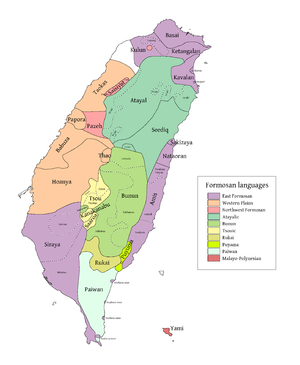| Tsouic | |
|---|---|
| Geographic distribution | Central Taiwan |
| Linguistic classification | Austronesian
|
| Proto-language | Proto-Tsouic |
| Subdivisions |
|
| Linguasphere | 30-EA |
| Glottolog | tsou1250 |
 (yellow) Greater Tsouic | |
The Tsouic languages (also known as the Central Formosan languages) are three Formosan languages, Tsou proper and the Southern languages Kanakanavu and Saaroa. The Southern Tsouic languages of Kanakanavu and Saaroa have the smallest phonemic inventories out of all the Formosan languages, with each language having only 13 consonants and 4 vowels (Blust 2009:165).[1] These two languages are highly endangered, as many Southern Tsouic speakers are shifting to Bunun and Mandarin Chinese.
The Proto-Tsouic language was reconstructed by Japanese linguist Shigeru Tsuchida in 1976, and is supported by Blust (1999), Li (2008), and Sagart (2014). However, Chang (2006)[2] and Ross (2009)[3] deny that Tsouic is a valid group; Ross places Southern Tsouic within Nuclear Austronesian (the family of the various proto-Austronesian reconstructions), but the Tsou language as a more divergent branch.
Sagart (2014) supports Tsouic on the basis on shared irregular phonological reflexes confined to specific terms, in addition to over 57 terms reconstructed by Tsuchida that appear in no other Austronesian clade.[4]
Classification
- Tsou
- Southern Tsouic
Sound changes
The following sound changes from Proto-Austronesian occurred in the Tsouic languages (Li 2008:215).[5]
- *C, *d > c
- *y > Proto-Tsouic *z
- *R > r
References
- ^ Blust, Robert A. The Austronesian Languages. Canberra: Pacific Linguistics, Research School of Pacific and Asian Studies, Australian National University, 2009. ISBN 0-85883-602-5, ISBN 978-0-85883-602-0.
- ^ Chang, Henry Yungli. 2006. "Rethinking the Tsouic Subgroup Hypothesis: A Morphosyntactic Perspective." In Chang, H., Huang, L. M., Ho, D. (eds.). Streams converging into an ocean: Festschrift in honor of Professor Paul Jen-Kuei Li on his 70th birthday. Taipei: Institute of Linguistics, Academia Sinica.
- ^ Ross, Malcolm. 2009. "Proto Austronesian verbal morphology: A reappraisal." In Alexander Adelaar and Andrew Pawley (eds.). Austronesian historical linguistics and culture history: a festschrift for Robert Blust. Canberra: Pacific Linguistics.
- ^ Sagart, Laurent (2014). "In Defense of the Numeral-based Model of Austronesian Phylogeny, and of Tsouic". Language and Linguistics. Taipei: Academia Sinica Institute of Linguistics. 15 (6): 859–882.
- ^ Li, Paul Jen-kuei. 2008. "Time perspective of Formosan Aborigines." In Sanchez-Mazas, Alicia ed. Past human migrations in East Asia: matching archaeology, linguistics and genetics. Taylor & Francis US.
Further reading
- Tsuchida, S. (1976). Reconstruction of Proto-Tsouic phonology. [Tokyo: Institute for the Study of Languages and Cultures of Asia and Africa, Tokyo Gaikokugo Daigaku.
- Chang, Henry Yungli (2006). "Rethinking the Tsouic Subgroup Hypothesis: A Morphosyntactic Perspective." In Chang, H., Huang, L. M., Ho, D. (eds.). Streams converging into an ocean: Festschrift in honor of Professor Paul Jen-Kuei Li on his 70th birthday. Taipei: Institute of Linguistics, Academia Sinica.
